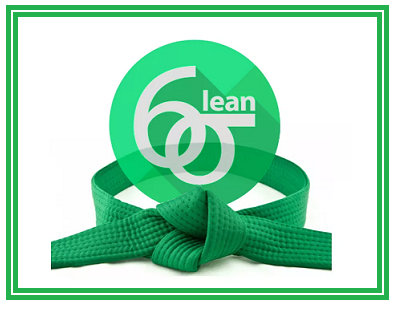Free Training & Career Tips... Subscribe to Get Weekly Career Tips

By Subscribing You are Agreeing to Terms and Conditions
If you are on a journey of learning more about Project Management and the need for streamlining business processes keep reading. In this article we will introduce you to three very significant methodologies: Lean, Six Sigma and Lean Six Sigma. Even if you have no experience with any of these concepts, you will gain a better understanding of what each one entails.
The Lean Methodology involves a systematic approach to reducing or eliminating tasks and activities within the process that don’t add value. The emphasis is around removing any wasteful steps and only taking those steps in the process that add value. The Lean methodology is geared towards high quality and customer satisfaction and helps to:
Lean is a continuous approach towards removing waste thus working towards a constant chain of improvements.
Almost 80-85% of all activities involved in any process are non-value adding. The goal of the LEAN methodology is to improve process efficiency and thus identify these non-value adding activities and use designated Lean tools to reduce or eliminate them.
It is also important to define what ‘value’ means in terms of Lean methodology at this stage. Hence, depending on the industry context and business process type, ‘value’ can be defined in terms of the customer’s perception of the products and services that he or she is prepared to pay for.
A ‘process’ is defined as an array of activities that use resources to convert inputs into outputs. These activities can be classified as follows:
Non-value-added activities are those that form the wasteful steps in the process and do not add value to the final product.
Value-added-activities are those that are essential to the process and improve processes in terms of quality and productivity.
Enabling value-added activities are those that while they do not add value to the customer, they are essential to the process.
The Lean methodology has its origins in the Toyota Production System (TPS). While the TPS methodology is suitable for a high-volume production environment, Lean can be applied in any environment where process waste occurs. Therefore, Lean can be applied to manufacturing as well as other typical service industries. With Lean, the approach is a step-by-step process of reducing waste. With its roots in the Toyota Production System, the 3M model (Muda, Mura, Muri) used in the Lean Process, reveals those inefficient processes that get in the way of generating customer value. Let us take a look at the 3M model in greater detail:
Muda relates to those activities that do not add value to the customer in terms of the creation of the product or service. Initially, 7 types of Lean waste were identified in manufacturing processes. Further down the line, an 8th waste was added. Removing these wastes was thought to be the key in delivering value to the customer.
Overproduction: This refers to producing earlier, more rapidly or in higher quantities than customer demand.
Inventory: This refers to keeping raw materials, works in progress or finished items that do not add value.
Waiting: This refers to people or parts that are waiting for a cycle to be completed.
Motion: This refers to the unnecessary movement of people, parts or machines within a process.
Transportation: This refers to the unnecessary movement of parts or people between processes.
Rework: This refers to not getting it right first time round, process repetition or the correction or modification of a process.
Over Processing: This refers to processing that is beyond the standard that customers require.
Underutilization of skills: This refers to inadequate and ineffective deployment of human resources.
Mura deals with those variations in business operations that lead to production inconsistencies. Production or process deviations result in the under-utilisation of resources. Accumulation of inventory, uneven workloads and waiting are some examples of where Mura is present. If Mura exists anywhere in the process, Muda follows.
Muri transpires as a result of too much stress and strain being placed upon human resources as well as machines. Office staff working for excessively long periods and clocking up overtime and the overuse of machinery in manufacturing plants are examples of Muri. When processes do not optimise resources, this leads to dissatisfaction among individuals or machine downtime, even though outcomes might still be achieved. The presence of Muri also leads to Muda.
While the 3M Model outlines the concepts of Muda, Mura and Muri, to pinpoint those inefficient processes that hamper the generation of customer value, another model for removing waste makes use of the acronym ‘DOWNTIME’. This is further expanded upon as follows:
| Waste | Waste Definition |
| Defects | The time and effort involved in searching for and rectifying errors and the emergence of other errors in the rework process. |
| Overproduction | The production of an excess amount of products or services beyond what customers require or what the downstream process can make use of. |
| Waiting | The occurence of idle time due to various inputs such as materials, information, people, or equipment not being ready on time. This can include long job set-up time in a manufacturing process or disproportionately long data processing time in the services industry. |
| Non-utilised Talent | Employee skills and creativity not being effectively leveraged. Empowering employees can counter this waste. |
| Transportation | Products, equipment, information, materials or people being moved from one place to another without adding any value to the final product or service. |
| Inventory | Unnecessary or unwanted stock or storage of information and/or materials. |

Lean principles can be applied to any process with the aim of reducing wastes. There are 5 Lean principles as follows:
It is the customer who determines a product or service’s value. Therefore, the first task is to identify customers. Questions should be asked, such as: what does the customer value? What are customers’ expectations? Organise the process activities into Non-Value added, Value-addded and enabling Value-added processes.
Mapping the value stream highlights the steps in the workflow process. Mapping the value stream assists in identifying and removing non-value added activities and tasks.
Creating flow is a key concept of the Lean process, since waiting in any form constitutes waste. When creating a flow of value, the goal is to aim for smooth delivery from the moment an order is received through to the point of customer delivery.
Establishing a pull approach enables one to meet system beat time. Beat time is defined as the rate at which a product should be ready in order to meet customer demand. Just-in-time or JIT is an inventory management approach promoting the pull system, whereby goods are received from suppliers only as an when needed. This method reduces inventory holding costs and increases inventory turnover.
Seeking continuous improvement means applying consistent efforts to improve existing processes to meet the ever-changing needs of customers while removing waste and defects.
As previously mentioned, Value Stream Mapping assists in identifying process wastes and how these wastes occur.
Kaizen is a continuous improvement method that focusses on small improvements to a process. It involves the commitment of first-line management towards process improvements, with management support and implemented by subordinates.
As previously mentioned, the Just in Time (JIT) method is a pull approach that ensures that customers only take delivery of products as and when required.
SMED (Single-Miinute Exchange of Die) is a system that is used to dramatically reduce the time it takes to complete equipment changeovers. The crux of the SMED system is to switch as many changeover steps as possible to ‘external’ steps which is done while the equipment is running an to streamline and shorten the remaining steps.
Poka Yoke is a Japanese term that translates as ‘mistake-proofing’ or ‘inadvertent error prevention.’ Therefore, a poka-yoke is any device or mechanism within a process that assists an equipment operator in avoiding mistakes and defects by preventing, correcting or highlighting human errors as and when they arise.
Jidoka is another Japanese term that translates as ‘autonomation’ which is a combination of the words autonomous and automation and and literally means ‘human touch’. It is implemented in the Lean process to automatically stop machines from running upon detecting an abnormal condition. Operators then try to fix the defect to prevent the situation from recurring.
Heijunka refers to the approach that is used to reduce the unevenness of a production process. It is also referred to as Line Balancing and the aim is to distribute the production load evenly by balancing production lines.
Gemba is another Japanese term, and it literally translates as ‘the actual place’. To Gemba means to go and visit the frontlines to look for evidence of waste and areas that need improvement. The Gemba walk is similar to Management by Walking Around (MBWA).
Kanban is a Japanese term that translates as ‘the actual place’ and is a visual system that is used to keep track of and manage work as it moves through a process. It is useful in managing inventory levels. Kanban boards are displayed in order to reflect current inventory levels on a real-time basis and alert management to excessive inventory levels.

Essentially, Six Sigma is a data-driven problem-solving methodology that focusses on variations in the process. The emphasis is around customer satisfaction and the aim of Six Sigma is to implement a continuous improvement process to ensure that as many defects as possible are minimised or eliminated from the process.
The objective of Six Sigma is to make a process 99.9996% defect-free. As a result, this means that a Six Sigma process produces 3.4 defects per million opportunities.
Six Sigma is focussed on problem-solving and is carried out using the DMAIC framework which has 5 distinct phases as follows:
This phase is where the aims and objectives of the project are outlined an the project charter is drawn up. The project charter is a critical element of this phase and can be seen as the Six Sigma project blueprint.
During this phase variables are measured, process data is collected, the baseline is established and metrics are compared with the final performance metrics.
This is the phase where the root cause analysis is established. To identify the root causes of a defect requires complex analysis tools such as Pareto Charts, Histograms and Fishbone diagrams. Hypotheses testing such as the ANOVA Test, Regression Test and Chi-square Test is also carried out to validate and verify root causes.
The Improve phase kicks in once the final root causes have been identified. At this stage, solutions need to be derived in order to remove the root causes. Tools such as Design of Experiments, Prototyping and Simulations Studies are used to enhance process performance.
Once root cause solutions have been implemented, the effectiveness of these solutions must be recorded. In other words, a system of control should be put in place to monitor performance. A response plan is also generated with the purpose of addressing solution failure. Control charts are also used to demonstrate process performance and actual project benefits are discussed and verified against estimated benefits.

According to the American Society for Quality (ASQ):
“Lean Six Sigma is a fact-based, data-driven philosophy of improvement that values defect prevention over defect detection. It drives customer satisfaction and bottom-line results by reducing variation, waste, and cycle time while promoting the use of work standardization and flow, thereby creating a competitive advantage. It applies anywhere variation and waste exist, and every employee should be involved.”
Thus, Lean Six Sigma amalgamates the strategies of Lean and Six Sigma. Where Lean principles assist in reducing or eliminating process wastes, Six Sigma concentrates on reducing variations within the process.
There are three key elements of Lean Six Sigma:
The old saying ‘the proof of the pudding is in the eating’ applies here. That is, the moment of truth for the customer is the product or service experience. Customers today are overwhelmed with more information and choices than ever before. They also demand more at a cheaper price and expect support throughout their experience with the product. This requires an approach that deals with business processes from the outside in, which is the crux of what Six Sigma entails.
An outside-in approach requires the business process value chain to be defined. In order to derive the best quality within expected timelines, Lean Six Sigma therefore assists organisations in focussing on consistently producing quality outputs and improving the value chain.
Lean Six Sigma should be entrenched within the DNA of the organisation for it to be wholly effective. In other words, employee buy-in is critical as stakeholders at all levels of the organisation need to be singing from the same hymn sheet.
The ever-changing dynamics in today’s world mean that, in isolation, the Lean or Six Sigma methodologies cannot bring to the fore every improvement scenario. Hence, when the two work hand in hand, this ensures exceptional improvements with Lean at first removing the waste and Six Sigma improving process variations. The amalgamation of these two methodologies assists in developing streamlined processes, high quality and exceptional results.
Within the Lean Six Sigma (LSS) school of knowledge different belt levels indicate the different levels of certification as follows:

Reference sources: ntaskmanager.com|trekglobal.com|greycampus.com|6 Sigma Certification Online|Wikipedia
Copyright text 2024 by Business Optimization Training Institute.